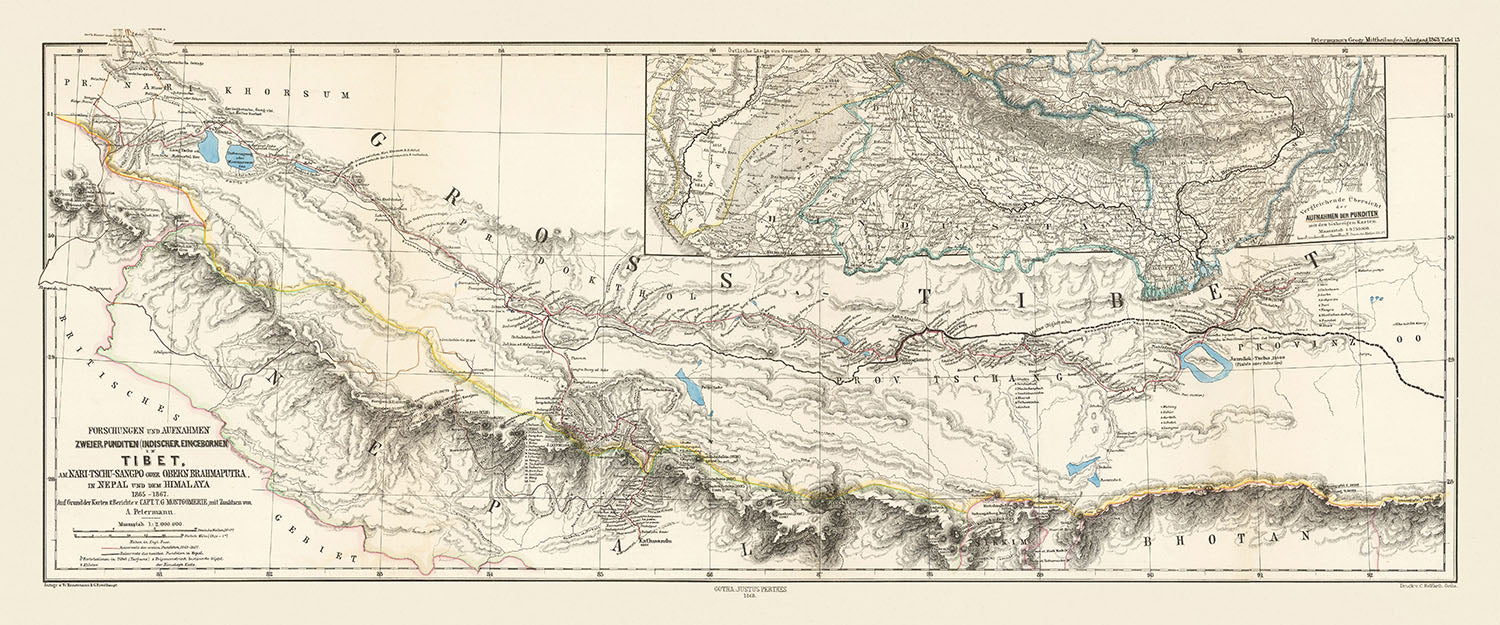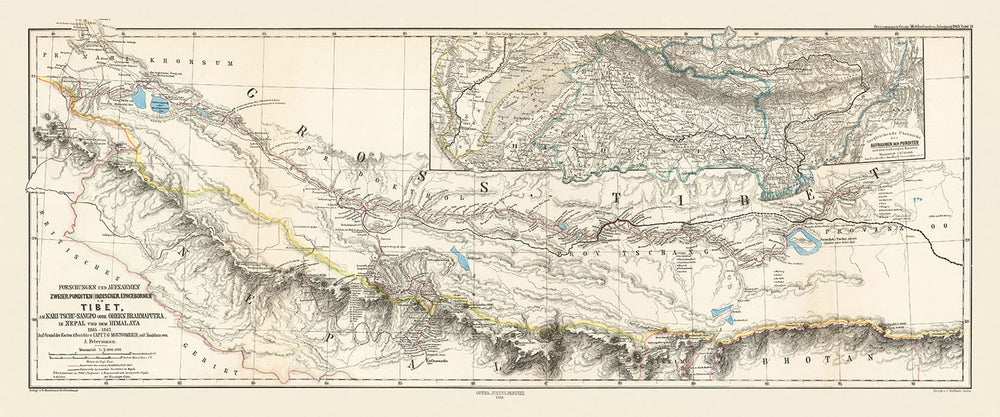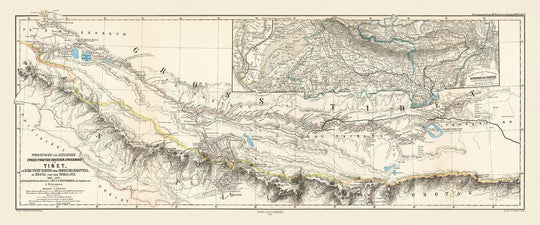- Handmade locally. No import duty or tax
- FREE Delivery by Christmas
- Love it or your money back (90 days)
- Questions? WhatsApp me any time
Own a piece of history
5,000+ 5 star reviews


Step into the rich tapestry of history with this exquisite map, "Forschungen und Aufnahmen Zweier Punditen (Indischer Eincebornen) In Tibet, Am Nari-Tschu-Sangpo Oder Obern Brahmaputra, In Nepal Und Dem Himalaya 1865-1867," crafted by the renowned cartographer Augustus Herman Petermann in 1868. This hand-colored lithographed map offers a detailed glimpse into the Roof of the World, including the Sikkim-Bhutan-Tibet Tri-border Region. Created just three years after Mount Everest was named by the British Royal Geographical Society, this map is a testament to the meticulous surveying efforts of the 19th century, capturing the essence of a region that has long fascinated explorers and scholars alike.
One of the most compelling aspects of this map is its depiction of the Sikkim-Tibet border, which was later formalized in the 1890 Convention of Calcutta. The map provides several landmarks that were crucial in establishing this boundary, a topic that continues to have geopolitical implications for China and India today. The intricate details and annotations offer a window into the complex territorial claims and the historical context of the late 19th century, making it a valuable piece for anyone interested in the geopolitical history of the region.
The map also highlights the pioneering work of Capt. T. G. Montgomerie, a British surveyor who played a significant role in the Great Trigonometric Survey of India. Montgomerie was responsible for labeling K2, the second highest mountain in the world, and his contributions are evident in the accurate elevations and detailed topographical features depicted on this map. Despite the challenges of surveying in such a remote and often inaccessible region, the work carried out by Montgomerie and his team has stood the test of time, with their calculated elevations closely matching those accepted today.
Beyond its historical and geopolitical significance, this map is a visual delight, showcasing the natural beauty and rugged terrain of the Himalayan region. From the majestic peaks of the Himalayas and the Karakoram range to the winding courses of the Nari-Tschu-Sangpo (Upper Brahmaputra) and other major rivers, the map captures the diverse landscapes that define this part of the world. The hand-colored regions and detailed annotations add an artistic touch, making it not just a map but a piece of art that tells a story of exploration and discovery.
For collectors and history enthusiasts, this map is more than just a navigational tool; it is a piece of history that encapsulates the spirit of 19th-century exploration and the enduring quest to understand our world. Whether displayed in a study, library, or gallery, it serves as a constant reminder of the human drive to explore, map, and ultimately connect with the farthest reaches of our planet. This map is a rare find, offering both aesthetic appeal and a deep historical narrative that will enrich any collection.
Places on this map
- Mount Everest
- Sikkim
- Bhutan
- Tibet
- Nepal
- Almora
- Nari-Tschu-Sangpo (Upper Brahmaputra)
- Ganges Watershed
- Indus Watershed
- Lhasa
- Kathmandu
- Darjeeling
- Simla
- Leh
- Chumbi Valley
- Nyang Chu River
- Manasarovar Lake
- Rangpur
- Gorakhpur
Notable Features & Landmarks
- Mount Everest: Located and labeled on the map.
- Sikkim-Bhutan-Tibet Tri-border Region: Detailed depiction.
- Nari-Tschu-Sangpo (Upper Brahmaputra): River system shown.
- Ganges Watershed: Shown in the inset map.
- Indus Watershed: Shown in the inset map.
- Sikkim-Tibet Border: Detailed landmarks for establishing the border.
- Major summits: Various peaks in the Himalayas.
- Topographical features: Detailed depiction of mountains, rivers, and valleys.
- Routes and trails: Surveyed paths and trails.
- Hand-colored regions: Differentiating various territories.
- Inset map: Provides a larger overview of the region.
- Surveyor routes: Paths taken by the Indian pundits.
- Geographical names: Various locations and features labeled.
- Mountain ranges: Detailed depiction of the Himalayan and Karakoram ranges.
- Rivers: Several major rivers and their tributaries.
- Lakes: Notable lakes in the region.
- Historical survey lines: Routes taken by surveyors.
- Elevation data: Information on the elevations of major summits.
- Cultural landmarks: Important cultural sites in the region.
- Administrative boundaries: Borders between different regions.
- Geopolitical annotations: Notes on territorial claims and boundaries.
- Natural features: Detailed depiction of natural landscapes.
- Surveyor notes: Annotations from the survey work.
Historical and design context
- Name of the map: Forschungen und Aufnahmen Zweier Punditen (Indischer Eincebornen) In Tibet, Am Nari-Tschu-Sangpo Oder Obern Brahmaputra, In Nepal Und Dem Himalaya 1865-1867
- Mapmaker/Publisher: Augustus Herman Petermann, 1868
- Context about the mapmaker: Augustus Herman Petermann was a notable cartographer in the 19th century. His work includes detailed maps of various regions, contributing significantly to geographical knowledge.
- Date of creation: 1868
- Historical significance:
- The map includes the Sikkim-Bhutan-Tibet Tri-border Region.
- It locates Mount Everest, named only three years prior by the British Royal Geographical Society.
- It provides landmarks for the Sikkim-Tibet border, which was formalized in the 1890 Convention of Calcutta.
- The map reflects the geopolitical implications of late-19th-century territorial claims between China and India today.
- Notable individuals:
- Capt. T. G. Montgomerie: British surveyor involved in the Great Trigonometric Survey of India, labeled K2.
- Themes and topics:
- Geopolitical boundaries: Shows the Sikkim-Bhutan-Tibet Tri-border Region.
- Topography: Detailed physical features of the Himalayan region.
- Surveying history: Reflects the work of Indian pundits trained by British surveyors to map Tibet.
- Design/Style:
- Hand-colored lithographed map.
- Detailed physical features and landmarks.
- Inset map showing the Ganges and Indus watersheds.
- Countries and regions shown:
- Tibet
- Nepal
- Bhutan
- India (including the eastern border of Bhutan and Almora)
Please double check the images to make sure that a specific town or place is shown on this map. You can also get in touch and ask us to check the map for you.
This map looks great at every size, but I always recommend going for a larger size if you have space. That way you can easily make out all of the details.
This map looks amazing at sizes all the way up to 50in (125cm). If you are looking for a larger map, please get in touch.
Please note: the labels on this map are hard to read if you order a map that is 16in (40cm) or smaller. The map is still very attractive, but if you would like to read the map easily, please buy a larger size.
This map is wider than most maps, which would make it a perfect statement piece above a mantelpiece, sofa or desk.
The fifth listing image shows an example of my map personalisation service.
If you’re looking for something slightly different, check out my collection of the best old maps to see if something else catches your eye.
Please contact me to check if a certain location, landmark or feature is shown on this map.
This would make a wonderful birthday, Christmas, Father's Day, work leaving, anniversary or housewarming gift for someone from the areas covered by this map.
This map is available as a giclée print on acid free archival matte paper, or you can buy it framed. The frame is a nice, simple black frame that suits most aesthetics. Please get in touch if you'd like a different frame colour or material. My frames are glazed with super-clear museum-grade acrylic (perspex/acrylite), which is significantly less reflective than glass, safer, and will always arrive in perfect condition.
This map is also available as a float framed canvas, sometimes known as a shadow gap framed canvas or canvas floater. The map is printed on artist's cotton canvas and then stretched over a handmade box frame. We then "float" the canvas inside a wooden frame, which is available in a range of colours (black, dark brown, oak, antique gold and white). This is a wonderful way to present a map without glazing in front. See some examples of float framed canvas maps and explore the differences between my different finishes.
For something truly unique, this map is also available in "Unique 3D", our trademarked process that dramatically transforms the map so that it has a wonderful sense of depth. We combine the original map with detailed topography and elevation data, so that mountains and the terrain really "pop". For more info and examples of 3D maps, check my Unique 3D page.
For most orders, delivery time is about 3 working days. Personalised and customised products take longer, as I have to do the personalisation and send it to you for approval, which usually takes 1 or 2 days.
Please note that very large framed orders usually take longer to make and deliver.
If you need your order to arrive by a certain date, please contact me before you order so that we can find the best way of making sure you get your order in time.
I print and frame maps and artwork in 23 countries around the world. This means your order will be made locally, which cuts down on delivery time and ensures that it won't be damaged during delivery. You'll never pay customs or import duty, and we'll put less CO2 into the air.
All of my maps and art prints are well packaged and sent in a rugged tube if unframed, or surrounded by foam if framed.
I try to send out all orders within 1 or 2 days of receiving your order, though some products (like face masks, mugs and tote bags) can take longer to make.
If you select Express Delivery at checkout your order we will prioritise your order and send it out by 1-day courier (Fedex, DHL, UPS, Parcelforce).
Next Day delivery is also available in some countries (US, UK, Singapore, UAE) but please try to order early in the day so that we can get it sent out on time.
My standard frame is a gallery style black ash hardwood frame. It is simple and quite modern looking. My standard frame is around 20mm (0.8in) wide.
I use super-clear acrylic (perspex/acrylite) for the frame glass. It's lighter and safer than glass - and it looks better, as the reflectivity is lower.
Six standard frame colours are available for free (black, dark brown, dark grey, oak, white and antique gold). Custom framing and mounting/matting is available if you're looking for something else.
Most maps, art and illustrations are also available as a framed canvas. We use matte (not shiny) cotton canvas, stretch it over a sustainably sourced box wood frame, and then 'float' the piece within a wood frame. The end result is quite beautiful, and there's no glazing to get in the way.
All frames are provided "ready to hang", with either a string or brackets on the back. Very large frames will have heavy duty hanging plates and/or a mounting baton. If you have any questions, please get in touch.
See some examples of my framed maps and framed canvas maps.
Alternatively, I can also supply old maps and artwork on canvas, foam board, cotton rag and other materials.
If you want to frame your map or artwork yourself, please read my size guide first.
My maps are extremely high quality reproductions of original maps.
I source original, rare maps from libraries, auction houses and private collections around the world, restore them at my London workshop, and then use specialist giclée inks and printers to create beautiful maps that look even better than the original.
My maps are printed on acid-free archival matte (not glossy) paper that feels very high quality and almost like card. In technical terms the paper weight/thickness is 10mil/200gsm. It's perfect for framing.
I print with Epson ultrachrome giclée UV fade resistant pigment inks - some of the best inks you can find.
I can also make maps on canvas, cotton rag and other exotic materials.
Learn more about The Unique Maps Co.
Map personalisation
If you're looking for the perfect anniversary or housewarming gift, I can personalise your map to make it truly unique. For example, I can add a short message, or highlight an important location, or add your family's coat of arms.
The options are almost infinite. Please see my map personalisation page for some wonderful examples of what's possible.
To order a personalised map, select "personalise your map" before adding it to your basket.
Get in touch if you're looking for more complex customisations and personalisations.
Map ageing
I have been asked hundreds of times over the years by customers if they could buy a map that looks even older.
Well, now you can, by selecting Aged before you add a map to your basket.
All the product photos you see on this page show the map in its Original form. This is what the map looks like today.
If you select Aged, I will age your map by hand, using a special and unique process developed through years of studying old maps, talking to researchers to understand the chemistry of aging paper, and of course... lots of practice!
If you're unsure, stick to the Original colour of the map. If you want something a bit darker and older looking, go for Aged.
If you are not happy with your order for any reason, contact me and I'll get it fixed ASAP, free of charge. Please see my returns and refund policy for more information.
I am very confident you will like your restored map or art print. I have been doing this since 1984. I'm a 5-star Etsy seller. I have sold tens of thousands of maps and art prints and have over 5,000 real 5-star reviews. My work has been featured in interior design magazines, on the BBC, and on the walls of dozens of 5-star hotels.
I use a unique process to restore maps and artwork that is massively time consuming and labour intensive. Hunting down the original maps and illustrations can take months. I use state of the art and eye-wateringly expensive technology to scan and restore them. As a result, I guarantee my maps and art prints are a cut above the rest. I stand by my products and will always make sure you're 100% happy with what you receive.
Almost all of my maps and art prints look amazing at large sizes (200cm, 6.5ft+) and I can frame and deliver them to you as well, via special oversized courier. Contact me to discuss your specific needs.
Or try searching for something!
















































